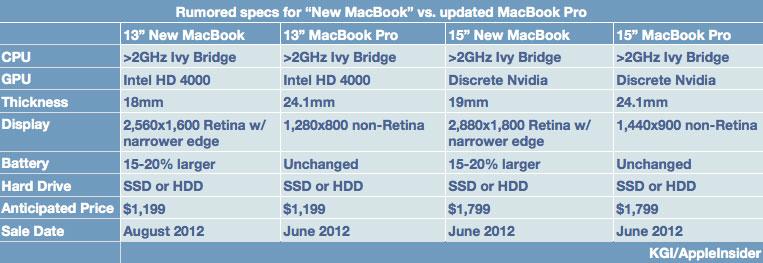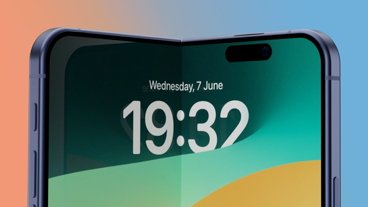For months, Apple has been expected to introduce new, thinner MacBook Pros with high-resolution Retina displays. The notebooks are expected to take design cues from Apple's MacBook Air, but offer more power than the ultraportable notebook.
But on Friday, AppleInsider was first to report on a research note from analyst Ming-Chi Kuo with KGI, who indicated that the redesigned thinner notebook will instead be a new MacBook series, rather than a MacBook Pro. Kuo said he expects Apple to update and continue to sell the MacBook Pro, complete with an optical disc drive, for the near future.
However, beyond that, Kuo said he believes Apple plans to discontinue the MacBook Pro lineup in 2013, if the "new MacBook" proves as successful as the company hopes.
Kuo expects the MacBook Pro branding to live on in the short-term with new 13- and 15-inch notebooks featuring the same design as the current Pro models. But the updated MacBook Pros and "new MacBooks" are expected to have essentially identical horsepower, raising some important questions: Why would Apple offer two products that are so similar? Further, if Apple does actually retire the 17-inch MacBook Pro, why offer two competing notebooks in identical sizes of 13- and 15-inch screens?
Apple's rumored notebook shakeup, if true, could be the company's way of slowly renaming its lineup to simply "MacBook." Losing the "Pro" name by next year could be compared to how Apple ditched the generational numbering scheme with its new iPad. Some have also suggested Apple also intends to call its sixth-generation iPhone just the "new iPhone," continuing the same theme of simplified product names.
So what exactly would be the difference between the rumored "new MacBook" and the refreshed MacBook Pro products? Most notably, the legacy MacBook Pro would maintain the optical disc drive and thicker form factor currently found on the MacBook Pro lineup.
And while the updated MacBook Pros would look largely identical, the "new MacBook" is expected to offer a number of features not found in the MacBook Pro, allowing it to stand out from its counterpart beyond their identical performance capabilities. Namely, the "new MacBook" is rumored to exclusively feature:
- A slimmer form factor of about 18mm for the 13-inch model and 19mm for the 15-inch
- No optical disc drive on any models
- Retina display resolutions of 2,560-by-1,600 for the 13-inch, and 2,880-by-1,800 for the 15-inch
- Edges outside the display 50 percent narrower than the MacBook Pro
- A larger battery capacity about 15 to 20 percent greater than the MacBook Pro
Both the 13-inch "new MacBook" and updated 13-inch MacBook Pro are expected to have integrated Intel graphics, while the 15-inch varieties of both devices are said by Kuo to have discrete Nvidia graphics cards.
Those anticipated changes corroborate with a leaked specification sheet for a new 13-inch MacBook Pro that surfaced earlier this week. It showed an updated model with Intel's latest-generation Ivy Bridge processor and high-speed USB 3.0 ports, but no high-resolution Retina display.
So, is the "new MacBook" expected to be more of an "Air" or a "Pro?" Kuo thinks Apple will focus on the "Air" aspect of the new product, highlighting its new slim and light enclosure as the defining feature of the new MacBook series. He thinks the slimness of the "new MacBook" will be a greater selling point to consumers than its computational ability.
As Apple makes its notebooks thinner and ditches optical drives, Kuo expects Windows PC makers to follow suit in 2013. He noted that many companies are currently taking a "wait-and-see attitude" on where to go next.
"Even so, we think it will remain difficult for non-Apple (notebook) brands to make products that can match up to the new MacBook," Kuo wrote in his note to investors on Friday. "Aside from the enormous resources that Apple has put into designing a slimmer product, limited supply and higher cost of (notebook Retina displays) are a key hinderance."
 Neil Hughes
Neil Hughes








-m.jpg)






 Malcolm Owen
Malcolm Owen
 William Gallagher
William Gallagher
 Charles Martin
Charles Martin
 Christine McKee
Christine McKee
 Wesley Hilliard
Wesley Hilliard

 Andrew Orr
Andrew Orr









114 Comments
Why would the 13" AND the 15" have 2560x1600?
And I only ask that because the 15" sticker we saw said that and not 2880x1800.
Well, SJ did say, when they unveiled the current form-factor MBAs that Apple saw that as the future of the laptop, so this shouldn't come as a surprise.
Why would the 13" AND the 15" have 2560x1600?
And I only ask that because the 15" sticker we saw said that and not 2880x1800.
It's all rumors, Tally. Have patience until Monday.
The 15-inch sounds too good be true.
CC at the ready, is the prediction here are even close. (Of course, assuming at least a 512GB SSD).
That makes no sense. The MacBook was an entry level notebook that had just above adequate specs. This one is better than the MacBook Pro. And they're the same price? It doesn't make any sense. It would kill MacBook Pro sales.